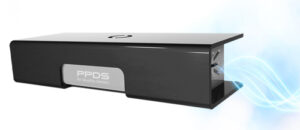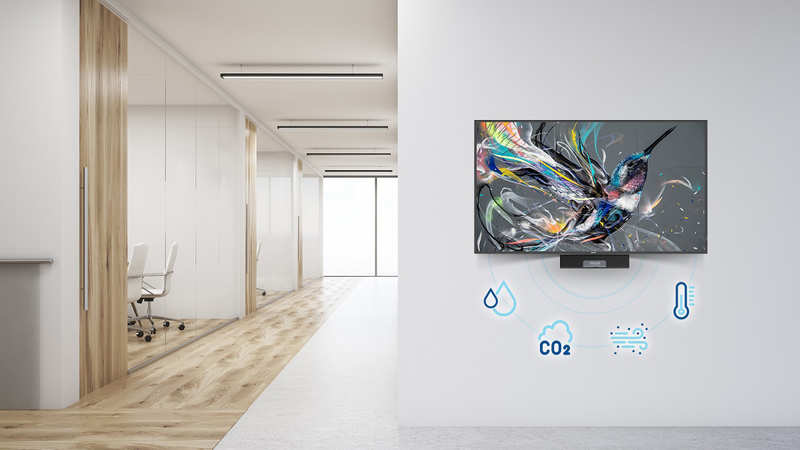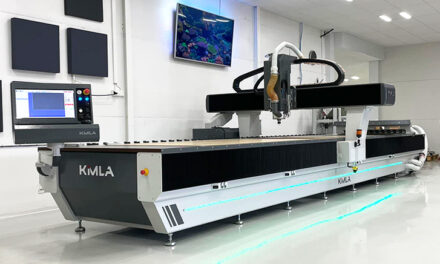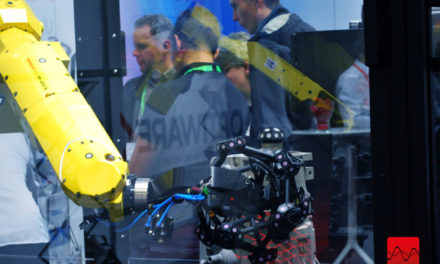New Philips professional display-powered plug and play, ‘PPDS Air Quality Sensor’ solution lets schools and businesses (including corporate, retail and hospitality) easily monitor the air quality inside classrooms and work environments – helping to improve the wellbeing, health and safety of staff, students and customers, as well as reducing the spread of potentially harmful and debilitating viruses.
PPDS is excited to announce the launch of ‘Air Quality Sensor’ – a brand new, highly advanced and innovative air quality monitoring solution, designed exclusively to help schools and businesses (including corporate, retail and hospitality) create healthier and more productive working and learning environments, using Philips professional TVs, interactive displays and digital signage solutions.
The PPDS Air Quality Sensor extends the role and benefits of its digital displays, bringing extensive health and economic benefits.

Shot of a businessman and businesswoman having a discussion in a modern office
Connected and powered by a single USB-A cable and compatible with PPDS’ latest Philips Professional TVs, digital signage and interactive displays – including MediaSuite (hospitality), T-Line (education), C-Line (corporate), B-Line (food and beverage / corporate), and Q-Line (universal) – the PPDS Air Quality Sensor ‘plug and play’ solution features four advanced sensors, which monitor air quality 24/7.
The four sensors measure room temperature, humidity, carbon dioxide and particulate matter, all of which can have a major impact on people’s health and wellbeing.
- Temperature: Influences virus infection rate and has an impact on performance in the classroom or workplace
- Humidity: Virus particles can remain highly infectious in humidity levels below 30% and above 55%
- Carbon dioxide: CO2 is an excellent indicator of indoor air quality and proper ventilation of a workspace or classroom
- Particulate matter: Higher levels of particle pollution can lead to greater risks of infections, not only COVID-19, but also other viral illnesses
Live data, whether for one PPDS Air Quality Sensor in a single room or building or installations across multiple sites, is analysed, translated and displayed in real time via an easily digestible dashboard and app – available anywhere at any time – with an indefinite archive of historical data available for extensive reporting and data analytics.
Whenever air quality is deemed to have fallen below a safe standard automatic alerts will be sounded, sent and displayed, providing opportunities to take immediate and necessary action. The app will even make tailored recommendations on improving the air quality based on its sensor readings, whether that’s something as simple as opening doors and windows, switching on air purifiers (if available), adjusting room temperatures, or even requesting that staff temporarily relocate to other areas of the building or from home.
 Small in size, PPDS Air Quality Sensor can be easily and neatly installed/attached to Philips professional displays in any environment, using a specially designed bracket and assembly kit, supplied in the box.
Small in size, PPDS Air Quality Sensor can be easily and neatly installed/attached to Philips professional displays in any environment, using a specially designed bracket and assembly kit, supplied in the box.
Chris Colpaert, General Manager at PPDS, commented: “With the spread of airborne viruses and other potentially harmful pollutants, monitoring indoor air quality is crucial to the health and safety of classrooms and work environments.
– PPDS Air Quality Sensor is a simple and incredibly effective solution that pairs perfectly with our advanced digital signage and professional TV solutions to bring safer and cleaner environments to people, whether they’re inside a classroom, corporate office, hotel room, a retail store, or any active indoor environment. Monitoring and managing air quality has never been more important, and we’ve made this a simple, seamless and affordable process.
Healthy building, healthy staff
Invisible to the eye, the quality of air being breathed in indoors has been proven to have a significant impact on a person’s wellbeing, affecting their short- and long-term health, reducing energy levels, focus, productivity and ability to process information.
Commonly described as ‘Sick Building Syndrome’ (SBS), poorly ventilated buildings can unknowingly be enhancing the risks and spread of common and highly infectious diseases and viruses, such as flu and bronchitis, while increasing the potential for staff absence and economic losses for both companies and staff.
According to the World Health Organization (WHO), symptoms of SBS can include headaches, dizziness, nausea, skin irritation, eye irritation, nose and throat irritation.
Martijn van der Woude, Director International Business Development at PPDS, continued:
– Like airborne viruses, the quality of air, (unless at very extreme levels) is not visible to the naked eye. This can be dangerous as it can easily become something that’s not considered, maybe even ignored. The risks are there, though, and they can pose a significant danger, both in the immediate and, perhaps more concerning, the long-term future. Being aware of these risks, taking preventative measures and, reassuringly, letting people know that their health is being taken seriously, is something that brings untold benefits – including reputationally.
He concluded:
– The statistics and impact on people’s health simply cannot be ignored and businesses, schools, retailers and the hospitality sector have a chance to reset and understand the clear link between poor air quality, absence and performance. It’s never been more important to have a healthy, happy and energetic people. The PPDS Air Quality Sensor is just the beginning of this story and we are continuing to develop our air quality solutions around our Philips professional displays. Watch this space….







